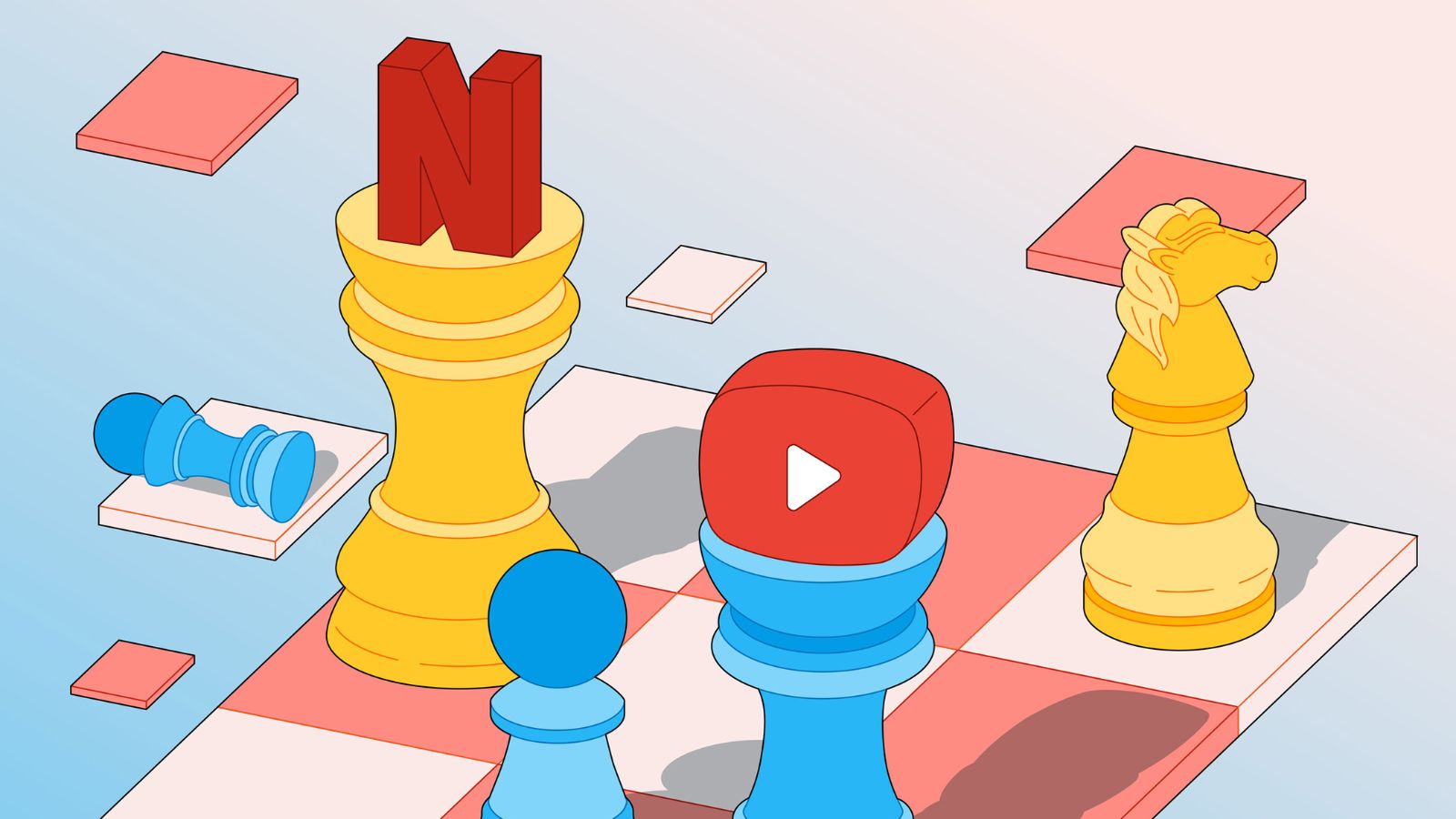For many years, Netflix executives bristled at the notion that the company really had a rival. Not Hollywood powerhouses like Disney, nor tech giants like Amazon. Instead, Reed Hastings, the company’s co-founder, insisted at one point that Netflix competed with people’s desire to socialize, or to go to sleep.
But there’s no hiding from YouTube.
Netflix and YouTube are increasingly locked in a fierce battle for control over the television set, a rivalry that even Netflix’s executives can no longer deny.
“That was more of a fun narrative than it was, you know, the brutal truth,” Jason Kilar, the founding CEO of Hulu and a former CEO of WarnerMedia, said about those past comments. “The brutal truth is that YouTube is indeed the biggest competitor of Netflix at this point.”
The rivalry signals how the streaming wars have entered a new phase.
For years, increasing subscriber numbers to their streaming services was the ultimate goal for media companies. Now, those companies are trying to increase the amount of time viewers spend on their service. On that score, YouTube and Netflix stand above the competition.
The two accounted for 20% of all television viewing time in the United States in May — 12.5% for YouTube, 7.5% for Netflix, according to Nielsen. The next closest streaming competitor is Disney, whose multiple streaming services (Disney+, Hulu, ESPN+) together accounted for 5% of TV time in May, Nielsen said.
And YouTube’s lead keeps getting wider. Two years ago, YouTube’s share of TV time was roughly half a percentage point higher than Netflix’s — now it is 5 percentage points.
Story continues below this ad
Their strategies for success are very different, but, in ways large and small, it’s becoming clear that they are now competing head-on. Top executives at both companies are beginning to mention each other in public more, sometimes dismissively. And the companies are veering into each other’s turf, with Netflix executives showing an increased appetite for signing up creators who otherwise call YouTube their home — and trying to explain why their business model would be better for them.
“Who is in the biggest fight around scale and eyeball aggregation? YouTube and Netflix,” said Ben Silverman, the chair of Propagate, a production company, and a former chair of NBC Entertainment.
Representatives for Netflix and YouTube declined to comment for this article.
Both companies are competing from a position of strength. Netflix’s revenue in 2024 reached $39 billion, and it has more than 300 million global subscribers, more than any other streaming service. The company is also hugely profitable: Netflix had more than $10 billion in operating income last year.
Story continues below this ad
YouTube, which is owned by Google, had revenue of $54 billion last year. The only media company with more was Disney. MoffettNathanson, a media analyst group, projected that YouTube would eclipse Disney in revenue this year and described it as “the new king of all media.” The company does not disclose profits, but MoffettNathanson estimated that YouTube’s operating income was just under $8 billion in 2024.
The two companies have very different approaches. Netflix is in the business of making and licensing traditional television shows, movies, documentaries, game shows or reality TV. The company hand-selects what it puts on its service, pays talent upfront and finances all the production costs, and often retains ownership of its original programs.
YouTube allows anyone to post almost anything. People who upload an original video shoulder the financial cost upfront, but they also collect a check from YouTube based on the amount of revenue it generates. Those creators generally own the rights to their content.
YouTube took a stab at making original TV shows but abandoned that game plan years ago. It worked. Now people go to YouTube for virtually anything, ranging from cat videos to music playlists to video podcasts.
Story continues below this ad
On average, YouTube has an audience of 7 million viewers watching off a TV set at any given moment during the day, more than Netflix’s daily average of 4.7 million, Nielsen said.
During prime-time hours, however, when the highest concentration of viewers is watching TV, the margins are tighter. An average of 11.1 million Americans are tuned into YouTube on their TV screens at night this year while 10.7 million are watching Netflix, Nielsen said.
Of course, Nielsen only measures viewership off a TV screen. Both companies have huge audiences that watch in other ways, including on a smartphone, tablet or laptop. Roughly 70% of Netflix’s audience, for instance, watches its programs via a television set, and the other 30% through other devices, the company said.
In March, at an event hosted by the Paley Media Council, Netflix co-CEO Ted Sarandos compared YouTube to the minor leagues. When a creator works with YouTube, he said, that person can “cut their teeth or develop an idea.”
Story continues below this ad
“It’s a little bit of a farm league,” he continued. “And then they can come up and do something that we would take the financial risk with them.”
Sarandos also suggested that Netflix remained a platform where you pay close attention to a program — an intentional choice essentially, perhaps during prime time — whereas YouTube was a far more passive viewing experience.
“There’s a difference between spending time and killing time,” he said. “We’re in the how-you-spend-time business.”
Neal Mohan, YouTube’s CEO, responded to Sarandos’ commentary at an advertiser event in France last month, emphasizing that viewers “get to decide how to spend” their time.
Story continues below this ad
“Who am I to say what’s spending time, engaging time, quality time, killing time?” he said, at an event hosted by The Ankler, an entertainment news outlet. “That’s, frankly, just the industry kind of talking to itself.”
And when Mohan was asked what he had been watching recently, he mentioned a documentary about Brett Favre before getting a jab in.
“It was on Netflix,” he said, “so I don’t know if I was killing time there.”
In recent months, Netflix has licensed shows from creators who used to be primarily on YouTube. “Ms. Rachel,” a children’s program that appears on YouTube, has also been streaming on Netflix since the beginning of the year, to great success. Netflix has also brought on shows like the game show “Pop the Balloon” and “Sidemen,” a popular British YouTube group. The company has also been in discussions with representatives from other popular YouTube channels, including Mark Rober, Dude Perfect, Danny Go and Gracie’s Corner, according to two people familiar with the negotiations.
Story continues below this ad
Jad Dayeh, a senior partner at the William Morris Endeavor talent agency, said Netflix executives had taken a much greater interest in YouTube over the past year or so.
“They’re unfazed by, like, Apple and HBO Max — it’s very clear that they do not care what Apple is doing,” he said. “But they’re more conscious of what YouTube is doing.”
Similarly, Oren Rosenbaum, a partner at the United Talent Agency, said: “They’re jealous of each other. I don’t think either one wants to admit that to themselves or each other. But when you have conversations with each of them, there is that jealousy.”
Both companies have tech roots. And in the tech world, there is often a competition between two or three top companies for leading market share in any given industry. Amazon battles Microsoft in cloud computing. Microsoft, Google and Amazon compete in the upper rungs of artificial intelligence. And Apple and Google go head-to-head for the top of the smartphone market.
Story continues below this ad
As with the competition between the iPhone and Android smartphones, Netflix and YouTube are essentially two different systems: a closed platform (Netflix) versus an open one (YouTube). And while Netflix’s recommendations for viewers are far ahead of many of its streaming competitors’, YouTube has more data inputs from users to make even more precise recommendations.
“When you open up YouTube you are going to get a far more surgical presentation of things to entertain you than you will ever get at a traditional streamer,” said Kilar, the former Hulu and WarnerMedia CEO.
Of course, within all of video entertainment, in particular mobile viewing, the companies also fiercely compete with TikTok and Instagram. But Kilar believes that in the coming years, Netflix will continue to take viewing share from its traditional Hollywood rivals. But he thinks YouTube has greater potential to expand its viewing time, given the growth trajectory of shorter videos, particularly with younger audiences.
“I’m bullish on both companies, make no mistake, but I am relatively more bullish on YouTube,” he said.
During the go-go cable years, entertainment executives used to repeat the mantra, “content is king.” Dayeh, the talent agent, said that these days “audience is king” — and two players stand to benefit the most.
“Netflix was like, ‘We want to be a studio,’ and they became a platform,” he said. “YouTube was a platform that is now becoming a studio. But what they both did was create these forums that are for everyone.
“That’s where the battle starts to really shape up,” he said, “because they’re competing for the same everyone audience.”





Average Rating